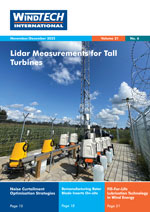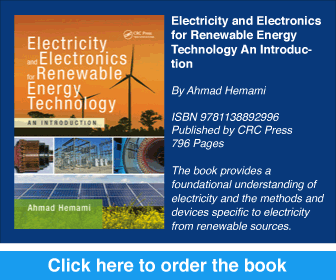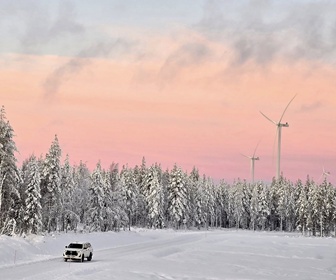- Category: Articles
Application of Tuned Liquid Column Dampers in Wind Turbines
With increasing turbine size, dynamic loading of the tower increases. With dampers, these loads can be reduced. The mass of conventional pendulum dampers is approximately 4% of the total turbine. The Tuned Liquid Column Damper (TLCD) provides a new solution that enables significant tower mass reduction, using only 2% of the effective mass. The tuning possibility facilitates on-site optimisation of damping characteristics. The TLCD enables reduction of the ‘cost of energy’ for both new and existing turbines.
By Arnold Wilmink and Ferdy Hengeveld, Mecal, The Netherlands
- Category: Articles
Generator, Gearing, Variable Speed and Power Electronics Improvements
 Over the past decade, land-based wind turbines have grown considerably. This up-scaling has caused problems by subjecting gearboxes and drive trains to heavy loads and stresses. In order to reduce loads and increase turbine lifespan, Clipper Windpower of Carpinteria, California, USA, has developed the 2.5MW Liberty wind turbine.
Over the past decade, land-based wind turbines have grown considerably. This up-scaling has caused problems by subjecting gearboxes and drive trains to heavy loads and stresses. In order to reduce loads and increase turbine lifespan, Clipper Windpower of Carpinteria, California, USA, has developed the 2.5MW Liberty wind turbine.By Drew Robb, Robb Editorial, USA
.
- Category: Articles
Braking Concepts for a Long Gear Lifetime
 Wind energy is environmentally friendly, yet it is not without competition. Preferences can quickly change to other sources of energy if wind turbines turn out to be too expensive or technically insecure. Despite the competitive struggle the wind energy business has with other sources of energy, there is also competition among the turbine manufacturers. The last few years have provided a little time to relax from the disaster of gear damage that shook almost the entire business. Mostly it was constantly hard applied fail-safe brakes that caused the damage to stall regulated machines. Fortunately, things have changed, but there are emerging Asian countries where manufacturers should learn from mistakes and experience in Europe so that they do not repeat the mistakes.
Wind energy is environmentally friendly, yet it is not without competition. Preferences can quickly change to other sources of energy if wind turbines turn out to be too expensive or technically insecure. Despite the competitive struggle the wind energy business has with other sources of energy, there is also competition among the turbine manufacturers. The last few years have provided a little time to relax from the disaster of gear damage that shook almost the entire business. Mostly it was constantly hard applied fail-safe brakes that caused the damage to stall regulated machines. Fortunately, things have changed, but there are emerging Asian countries where manufacturers should learn from mistakes and experience in Europe so that they do not repeat the mistakes.
By Andreas Gerken, Svendborg Brakes, Germany
.
 Wind energy is environmentally friendly, yet it is not without competition. Preferences can quickly change to other sources of energy if wind turbines turn out to be too expensive or technically insecure. Despite the competitive struggle the wind energy business has with other sources of energy, there is also competition among the turbine manufacturers. The last few years have provided a little time to relax from the disaster of gear damage that shook almost the entire business. Mostly it was constantly hard applied fail-safe brakes that caused the damage to stall regulated machines. Fortunately, things have changed, but there are emerging Asian countries where manufacturers should learn from mistakes and experience in Europe so that they do not repeat the mistakes.
Wind energy is environmentally friendly, yet it is not without competition. Preferences can quickly change to other sources of energy if wind turbines turn out to be too expensive or technically insecure. Despite the competitive struggle the wind energy business has with other sources of energy, there is also competition among the turbine manufacturers. The last few years have provided a little time to relax from the disaster of gear damage that shook almost the entire business. Mostly it was constantly hard applied fail-safe brakes that caused the damage to stall regulated machines. Fortunately, things have changed, but there are emerging Asian countries where manufacturers should learn from mistakes and experience in Europe so that they do not repeat the mistakes.By Andreas Gerken, Svendborg Brakes, Germany
- Category: Articles
What is the Best Way to Assess This?
 Turbine damage is still an everyday reality in the lifetime of a wind park. Owners are frustrated by repeated gearbox failures or blade repairs. In order to minimise failure rates and downtime it is becoming increasingly common to use independent assessors to check the status of the whole turbine or of certain critical parts like the gearbox or main bearings.
Turbine damage is still an everyday reality in the lifetime of a wind park. Owners are frustrated by repeated gearbox failures or blade repairs. In order to minimise failure rates and downtime it is becoming increasingly common to use independent assessors to check the status of the whole turbine or of certain critical parts like the gearbox or main bearings.By Jürgen Holzmüller, Dietmar Obst, Jochen Ziehmann and Rüdiger Kipke, 8.2, Germany
- Category: Articles
Energy Storage as a Matter of Urgency
 As the penetration of wind power increases in the UK, the issue of the unpredictability of wind power could create problems for electricity traders and network balancing mechanisms. Market penetration is currently less than 2%, but traders are already discounting wind-generated power. If no mitigation is implemented, this situation could worsen as market penetration increases towards the goal of 15% renewables by 2015. The solution may be to use electrolysis of water to create hydrogen fuel, with the electrolysis operation being determined by the needs of the electricity networks.
As the penetration of wind power increases in the UK, the issue of the unpredictability of wind power could create problems for electricity traders and network balancing mechanisms. Market penetration is currently less than 2%, but traders are already discounting wind-generated power. If no mitigation is implemented, this situation could worsen as market penetration increases towards the goal of 15% renewables by 2015. The solution may be to use electrolysis of water to create hydrogen fuel, with the electrolysis operation being determined by the needs of the electricity networks.
 As the penetration of wind power increases in the UK, the issue of the unpredictability of wind power could create problems for electricity traders and network balancing mechanisms. Market penetration is currently less than 2%, but traders are already discounting wind-generated power. If no mitigation is implemented, this situation could worsen as market penetration increases towards the goal of 15% renewables by 2015. The solution may be to use electrolysis of water to create hydrogen fuel, with the electrolysis operation being determined by the needs of the electricity networks.
As the penetration of wind power increases in the UK, the issue of the unpredictability of wind power could create problems for electricity traders and network balancing mechanisms. Market penetration is currently less than 2%, but traders are already discounting wind-generated power. If no mitigation is implemented, this situation could worsen as market penetration increases towards the goal of 15% renewables by 2015. The solution may be to use electrolysis of water to create hydrogen fuel, with the electrolysis operation being determined by the needs of the electricity networks.By Declan Pritchard, Wind Hydrogen Limited, UK
- Category: Articles
Setting the Framework for the Sahara Wind Energy Development Project
 The wind energy industry was initially encouraged to provide employment in the relatively poor North Sea regions of Germany. In the last 10 years, however, it has emerged as a major business providing most competitive prices of electricity even when operated under marginal European wind conditions. The trade winds that blow along the Atlantic coast from Morocco to Senegal represent the largest and most productive wind potentials available on Earth. Because of the erratic nature of winds, however, wind energy cannot be integrated locally on any significant scale unless far-ranging, more advanced energy technologies are considered. The Sahara Wind Energy Development Project is looking at ways in which these large trade wind resources could be used to benefit both North Africa and Europe.
The wind energy industry was initially encouraged to provide employment in the relatively poor North Sea regions of Germany. In the last 10 years, however, it has emerged as a major business providing most competitive prices of electricity even when operated under marginal European wind conditions. The trade winds that blow along the Atlantic coast from Morocco to Senegal represent the largest and most productive wind potentials available on Earth. Because of the erratic nature of winds, however, wind energy cannot be integrated locally on any significant scale unless far-ranging, more advanced energy technologies are considered. The Sahara Wind Energy Development Project is looking at ways in which these large trade wind resources could be used to benefit both North Africa and Europe.
By Khalid Benhamou, Sahara Wind Inc., Morocco
.
 The wind energy industry was initially encouraged to provide employment in the relatively poor North Sea regions of Germany. In the last 10 years, however, it has emerged as a major business providing most competitive prices of electricity even when operated under marginal European wind conditions. The trade winds that blow along the Atlantic coast from Morocco to Senegal represent the largest and most productive wind potentials available on Earth. Because of the erratic nature of winds, however, wind energy cannot be integrated locally on any significant scale unless far-ranging, more advanced energy technologies are considered. The Sahara Wind Energy Development Project is looking at ways in which these large trade wind resources could be used to benefit both North Africa and Europe.
The wind energy industry was initially encouraged to provide employment in the relatively poor North Sea regions of Germany. In the last 10 years, however, it has emerged as a major business providing most competitive prices of electricity even when operated under marginal European wind conditions. The trade winds that blow along the Atlantic coast from Morocco to Senegal represent the largest and most productive wind potentials available on Earth. Because of the erratic nature of winds, however, wind energy cannot be integrated locally on any significant scale unless far-ranging, more advanced energy technologies are considered. The Sahara Wind Energy Development Project is looking at ways in which these large trade wind resources could be used to benefit both North Africa and Europe.By Khalid Benhamou, Sahara Wind Inc., Morocco
- Category: Articles
Bachmann electronic’s M1 Control System
 The operation of modern and increasingly high-capacity wind energy installations makes many demands on automation technology. Modern pitch-controlled systems, which satisfy requirements of more precise and controlled power output in practically all wind and plant configurations, need relatively complex active control systems that can no longer be supplied by a simple programmable logic controller (PLC). In addition, increasingly common and urgent demands from network operators to correct frequency or reactive power fluctuations in the whole park call for previously unknown communication abilities. In this article, Bachmann electronic describe the capabilities of their new M1 control system, which was designed to meet these demands.
The operation of modern and increasingly high-capacity wind energy installations makes many demands on automation technology. Modern pitch-controlled systems, which satisfy requirements of more precise and controlled power output in practically all wind and plant configurations, need relatively complex active control systems that can no longer be supplied by a simple programmable logic controller (PLC). In addition, increasingly common and urgent demands from network operators to correct frequency or reactive power fluctuations in the whole park call for previously unknown communication abilities. In this article, Bachmann electronic describe the capabilities of their new M1 control system, which was designed to meet these demands.By Gabriel Schwanzer, Director Sales and Automation, Bachmann electronic, Austria










